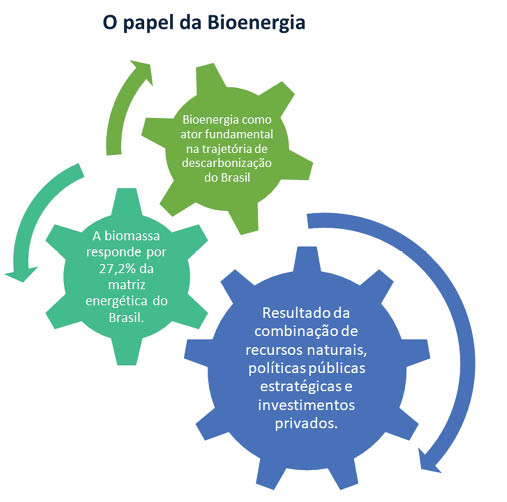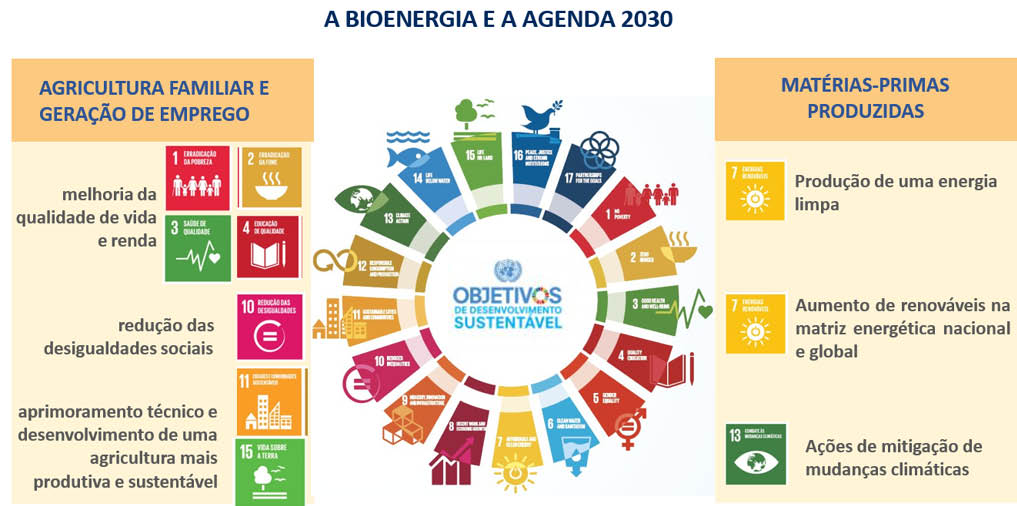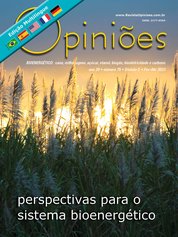Heloisa Borges Bastos Esteves
Diretora de Estudos do Petróleo, Gás Natural e Biocombustíveis da EPE - Empresa de Pesquisa Energética
OpAA75
Perspectivas e desafios para a próxima década
O Brasil é reconhecidamente um país com alta participação da energia renovável em sua matriz energética. O que poucos lembram é que quase 30% da renovabilidade da nossa matriz energética vem da biomassa. E essa situação deve perdurar e até se ampliar para os próximos anos. Isso porque a diversidade e a renovabilidade da matriz energética nacional não apenas são um dos atributos que contribuem para a segurança energética do Brasil, mas também porque as políticas voltadas ao incentivo da bioenergia têm inúmeras interfaces positivas com nossas ambições de descarbonização da economia e desenvolvimento socio-econômico.
Políticas públicas de incentivo ao uso de bioenergéticos, entretanto, não são novidade no cenário brasileiro. De fato, elas estão presentes desde a década de 1970, com a instituição do Proálcool, que visava à substituição de parte da gasolina no ciclo Otto, por questões econômicas e de segurança energética, seguida do lançamento, pela indústria automobilística, de motores a etanol.
Após um longo tempo de convivência dos carros movidos a etanol, e alguns percalços, a indústria automotiva lançou, em 2003, a tecnologia flex fuel, que facultava ao proprietário do veículo o uso de gasolina, etanol ou a mistura dos dois em qualquer proporção, o que impulsionou o consumo desse biocombustível no Brasil. No começo dos anos 2000, foi lançado o programa nacional de produção e uso de biodiesel (PNPB), com mandatos de substituição compulsória de parte do diesel fóssil, que tinham por objetivo inserir esse biocombustível de forma sustentável na matriz energética brasileira, com enfoque na inclusão social e no desenvolvimento regional. Finalmente, já na segunda década do século XXI, foi lançado o RenovaBio, política que visa estimular a fabricação e o uso de biocombustíveis, premiando os produtores mais eficientes, com uma visão mais ampla da importância estratégica da bioenergia na estratégia de descarbonização brasileira.
 Como se vê, os resultados que apresentamos hoje são fruto de um longo e consistente processo, que vem sendo aprimorado, cada vez mais, para que outros biocombustíveis (como biogás, bioquerosene de aviação e biocombustíveis avançados) possam também fazer parte da cesta de energéticos de baixa emissão de carbono na matriz energética.
Como se vê, os resultados que apresentamos hoje são fruto de um longo e consistente processo, que vem sendo aprimorado, cada vez mais, para que outros biocombustíveis (como biogás, bioquerosene de aviação e biocombustíveis avançados) possam também fazer parte da cesta de energéticos de baixa emissão de carbono na matriz energética.
Não obstante o destaque de o sistema bioenergético no Brasil, atualmente, ser o setor de transporte (com preponderância do etanol e o biodiesel), a bioeletricidade gerada com os resíduos das culturas energéticas também constitui importante produto dentro do portfólio do sistema bioenergético. Além da geração de eletricidade a partir do bagaço de cana, do cavaco de madeira e da palha de arroz, outros produtos, como a palha e ponta da cana e a lixívia, já estão sendo transformados em biogás, com grandes perspectivas para geração de energia elétrica, ou mesmo para uso em motores a combustão interna.
Uma grande vantagem do sistema bioenergético construído no Brasil é que, pelas nossas condições edafoclimáticas favoráveis e extensa disponibilidade de terra, os sistemas foram concebidos como sistemas integrados de produção de alimentos e energia, permitindo um planejamento que potencializa as vantagens, tanto para a produção de energia quanto para a produção de alimentos. De fato, nos últimos anos, as produtividades das culturas que fornecem a matéria-prima para a bioenergia vêm aumentando significativamente, o que permitirá, no futuro, menor uso de área agricultável.
O Plano Decenal de Expansão de Energia 2032 (PDE 2032), elaborado pela Empresa de Pesquisa Energética, empresa vinculada ao Ministério de Minas e Energia, indica que a oferta total de etanol alcançará 47 bilhões de litros em 2032, com destaque para o aumento da representatividade do etanol de milho (que atinge cerca de 20% da oferta total, chegando a 9 bilhões de litros no final da década).
A cana permanecerá como insumo principal para a produção do etanol e, com isso, os resíduos dessa cultura poderão ser utilizados para a expansão de geração de bioeletricidade, inclusive com a incorporação de palhas e pontas, o que permite que seja atingido o patamar de 4,1 GW médios (com potencial técnico para comercialização de até 6 GW médios em 2032).
O biogás do setor sucroenergético terá uma inserção cada vez maior no futuro. Versátil, o biocombustível pode ser destinado à geração elétrica em substituição ao diesel ou, ainda, misturado ao gás natural fóssil nas malhas de gasodutos. Estima-se que o potencial de produção de biogás, em 2032, seja de 35 bilhões de Nm³ (19 bilhões de Nm³ de biometano), oriundos da vinhaça e da torta de filtro e das palhas e pontas da cana-de-açúcar.
Para o biodiesel, os cenários de referência indicam que o óleo de soja permanece como a principal matéria-prima nos próximos anos e que a demanda por esse biocombustível atinja 12 bilhões de litros em 2032.
Entretanto, o desenvolvimento de outras culturas promissoras, como a palma e a macaúba, altamente produtoras de óleos, surge como potenciais insumos a serem agregados às matérias-primas para a produção nacional de biodiesel.
É importante avançarmos nas iniciativas para criar políticas públicas e aprofundar o conhecimento sobre os combustíveis sustentáveis de aviação e combustíveis de baixo carbono para o transporte marítimo. Espera-se que, em 2032, a participação de mercado desses biocombustíveis seja cerca de 2% da demanda total de combustíveis de aviação, mas ainda há espaço para avançarmos mais e mais rápido. E, ainda, além de todos os programas atualmente em curso, um grande desafio é pensar uma nova configuração do setor bioenergético, na qual as usinas, hoje produtoras de biocombustíveis e outros coprodutos, se integrem ainda mais em um novo sistema. Esse arranjo de biorrefinarias produzirá, além da energia, moléculas-base que possam substituir ou servir de insumos a uma grande cadeia integrada, como a indústria de cosméticos, alimentos e fármacos, impulsionando a bioeconomia.
Como última mensagem, reforço que o caminho para a bioeconomia e a transição energética no Brasil abre perspectivas claras para avançar em pontos importantes entre os 17 listados como Objetivos de Desenvolvimento Sustentável (ODS) propostos pela Organização das Nações Unidas (ONU), com destaque para:
• Assegurar uma vida saudável e promover o bem-estar para todos, em todas as idades;
• Assegurar o acesso confiável, sustentável, moderno e a preço acessível à energia para todos;
• Tornar as cidades e os assentamentos humanos inclusivos, seguros, resilientes e sustentáveis;
• Construir infraestruturas resilientes, promover a industrialização inclusiva e sustentável e fomentar a inovação;
• Assegurar padrões de produção e de consumo sustentáveis;
• Tomar medidas urgentes para combater a mudança climática e seus impactos;
• Proteger, recuperar e promover o uso sustentável dos ecossistemas terrestres, gerir de forma sustentável as florestas, combater a desertificação, deter e reverter a degradação da terra e deter a perda de biodiversidade.
Os sistemas bioenergéticos são fundamentais para atingir o objetivo de reduzir as emissões de gases de efeito estufa (GEE) e as suas consequentes influências nas mudanças climáticas. A posição privilegiada do Brasil quanto à renovabilidade dos seus recursos energéticos em relação ao restante do mundo é uma vantagem comparativa para liderar as ações rumo ao desenvolvimento sustentável, o combate às mudanças climáticas e a inovação tecnológica, condicionantes básicos para a rota da transição energética.
Esse é o nosso desafio, essa é a nossa meta.





